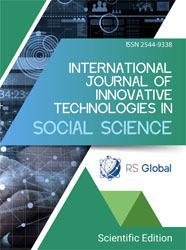THE ROLE OF ART THERAPY IN SCHOOLS: UNDERSTANDING THE CONTEXT, PRACTICE, AND EVIDENCE
Abstract
The role of art therapy in schools is investigated in this article, encompassing its background, techniques, and supporting evidence. This research, based on an initial review of scientific literature and prior studies, concentrates on the effects of art therapy in elementary schools, particularly in the context of global events like the pandemic that affect mental well-being. The results show the effectiveness of art therapy in treating a wide range of psychological and behavioral issues in children, including anxiety, depression, and ADHD. The presentation also highlights the role of art therapy in improving scholars’ social and emotional skills and academic performance. The research recommends integrating art therapy programs into educational institutions as an essential part of mental health support systems.
References
Abdel-Wahhab, A. A., &Shaaban, A. A. (2017). A proposed program based on art therapy (porcelain) to reduce attention deficit and hyperactivity in a sample of children. Scientific journal of the College of Specific Education. N°10, Part 02. 437-456 (In Arabic)
Case, C., &Dalley, T. (1992). The handbook of art therapy. Routledge, 264 pages.
Deboys, R., Holttum, S., & Wright, K. (2017). Processes of change in school-based art therapy with children: A systematic qualitative study. International Journal of Art Therapy, 22(3), 118-131. https://www.tandfonline.com/doi/full/10.1080/17454832.2016.1262882
Elmahi, Z. (2022). Art as a therapy to relieve symptoms of Attention Deficit/Hyper activity Disorder (ADHD), in children. Al-Academy, (106). 167-186. https://jcofarts.uobaghdad.edu.iq/index.php/jcofarts/article/view/1057/821 (In Arabic)
Hafez, A. O. (2022). The Effective Role of Fine Arts in Improving the Quality of Psychological Life in Light of Positive Psychology. Research in Art Education and Arts, 24(2), 471-477. https://seaf.journals.ekb.eg/article_361250_6121d89eef0b5aa0d96392fa76b43d8c.pdf (In Arabic)
Hu, J., Zhang, J., Hu, L., Yu, H., & Xu, J. (2021). Art Therapy: A Complementary Treatment for Mental Disorders. Frontiers in psychology, 12, 686005. https://doi.org/10.3389/fpsyg.2021.686005
McDonald, A., &Holttum, S. (2020). Primary-school-based art therapy: A mixed methods comparison study on children’s classroom learning. International Journal of Art Therapy, 25(3), 119–131. https://doi.org/10.1080/17454832.2020.1760906
McDonald, A., Holttum, S., & Drey, N. S. J. (2019). Primary-school-based art therapy: exploratory study of changes in children’s social, emotional and mental health. International Journal of Art Therapy, 24(3), 125–138. https://doi.org/10.1080/17454832.2019.1634115
Sutherland, J., Waldman, G., & Collins, C. (2010). Art therapy connection: Encouraging troubled youth to stay in school and succeed. Art Therapy, 27(2), 69-74. https://files.eric.ed.gov/fulltext/EJ901198.pdf
Deboys, R., Holttum, S., & Wright, K. (2017). Processes of change in school-based art therapy with children: A systematic qualitative study. International Journal of Art Therapy, 22(3), 118-131.http://create.canterbury.ac.uk/
UN. (2020). Policy Brief: Education during COVID-19 and beyond. https://www.un.org/development/desa/dspd/wp-content/uploads/sites/22/2020/08/sg_policy_brief_covid-19_and_education_august_2020.pdf
Viner, R., Russell, S., Saulle, R., Croker, H., Stansfeld, C., Packer, J., ... & Minozzi, S. (2021). Impacts of school closures on physical and mental health of children and young people: a systematic review. MedRxiv, 2021-02. https://doi.org/10.1101/2021.02.10.21251526
Waller D. Art therapy for children: how it leads to change. Clin Child Psychol Psychiatry. 2006 Apr;11(2):271-82. https://www.researchgate.net/profile/Diane-Waller-5/publication/6709804_Art_Therapy_for_Children_How_It_Leads_to_Change/links/53fcba0b0cf2dca8ffff42b7/Art-Therapy-for-Children-How-It-Leads-to-Change.pdf
Views:
113
Downloads:
54
Copyright (c) 2025 Said Aissaoui, Samia Djemai

This work is licensed under a Creative Commons Attribution 4.0 International License.
All articles are published in open-access and licensed under a Creative Commons Attribution 4.0 International License (CC BY 4.0). Hence, authors retain copyright to the content of the articles.
CC BY 4.0 License allows content to be copied, adapted, displayed, distributed, re-published or otherwise re-used for any purpose including for adaptation and commercial use provided the content is attributed.















